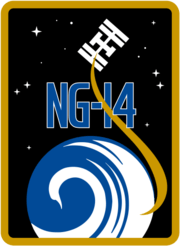Cygnus NG-14
Cygnus NG-14, previously known as CRS OA-14, is the fourteenth planned flight of the Northrop Grumman robotic resupply spacecraft Cygnus and its thirteenth flight to the International Space Station under the Commercial Resupply Services contract with NASA. The mission is scheduled to launch on 30 September 2020 at 02:26 UTC.[1] This is the third launch of Cygnus under the CRS-2 contract.[2]
| Mission type | ISS resupply |
|---|---|
| Operator | NASA |
| Spacecraft properties | |
| Spacecraft type | Enhanced Cygnus |
| Manufacturer | Northrop Grumman Thales Alenia Space |
| Start of mission | |
| Launch date | 30 September 2020, 02:26 UTC [1] |
| Rocket | Antares 230+ |
| Launch site | MARS, LP-0A |
| Contractor | Northrop Grumman |
| Orbital parameters | |
| Reference system | Geocentric orbit |
| Regime | Low Earth orbit |
| Inclination | 51.6° |
| Epoch | Planned |
| Berthing at ISS | |
| Berthing port | Harmony or Unity |
 | |
Orbital ATK (now Northrop Grumman Innovation Systems)[3] and NASA jointly developed a new space transportation system to provide commercial cargo resupply services to the International Space Station (ISS). Under the Commercial Orbital Transportation System (COTS) program, Orbital ATK designed, acquired, built, and assembled these components: Antares, a medium-class launch vehicle; Cygnus, an advanced spacecraft using a Pressurized Cargo Module (PCM) provided by industrial partner Thales Alenia Space and a Service Module based on the Orbital GEOStar satellite bus.[4][5]
History
Cygnus NG-14 is the third Cygnus mission under the Commercial Resupply Services-2 [6]
Production and integration of Cygnus spacecraft are performed in Dulles, Virginia. The Cygnus service module is mated with the pressurized cargo module at the launch site, and mission operations are conducted from control centers in Dulles and Houston.[4][5]
Spacecraft
This will be the ninth flight of the Enhanced-sized Cygnus PCM.[7]
Manifest
The Cygnus spacecraft is loaded with 0 kg (0 lb) of research, hardware, and crew supplies.
- Crew supplies: 0 kg (0 lb)
- Science investigations: 0 kg (0 lb)
- Spacewalk equipment: 0 kg (0 lb)
- Vehicle hardware: 0 kg (0 lb)
- Computer resources: 0 kg (0 lb)
Multi-Needle Langmuir Probe (m-NLP) instrument from the University of Oslo and the Norwegian company Eidsvoll Electronics to measure ionospheric plasma densities. With its relatively low orbit, the ISS passes near the peak plasma density of the ionosphere. The m-NLP is currently the only instrument in the world capable of resolving ionospheric plasma density variations at spatial scales below one-meter. m-NLP will be the first payload to be installed on the Bartolomeo Platform outside the European Columbus Module.[8]
ELaNa 31, Educational Launch of Nanosatellites, will deploy the following CubeSats from ISS:[9] Alpha, Bobcat-1, NEUTRON-1, and SPOC. IT-SPINS (SpaceBuoy), operated by Montana State University at Bozeman, will be externally deployed by the Cygnus spacecraft.
References
- "Launch Schedule". Spaceflight Now. 11 August 2020. Retrieved 12 August 2020.
- Gebhardt, Chris (1 June 2018). "Orbital ATK looks ahead to CRS-2 Cygnus flights, Antares on the commercial market". NASASpaceFlight.com. Retrieved 2 June 2018.
- Erwin, Sandra (5 June 2018). "Acquisition of Orbital ATK approved, company renamed Northrop Grumman Innovation Systems". SpaceNews. Retrieved 23 July 2018.
- "Cygnus Fact Sheet" (PDF). Orbital ATK. 24 March 2015. Archived from the original (PDF) on 26 September 2015. Retrieved 14 August 2015.
- "Cygnus Spacecraft". Northrop Grumman. 6 January 2020. Retrieved 9 April 2020.
- OIG Staff (26 April 2018). Audit of Commercial Resupply Services to the International Space Center (PDF) (Report). NASA Office of Inspector General. p. 24.

- Leone, Dan (17 August 2015). "NASA Orders Two More ISS Cargo Missions From Orbital ATK". SpaceNews.com. Retrieved 17 August 2015.
- Staff writers (24 January 2020). "ESA and Airbus sign contract for Bartolomeo platform on the International Space Station". Space Daily.
- "Upcoming ELaNa CubeSat Launches". NASA. 6 May 2020. Retrieved 7 May 2020.


